fuel PONTIAC BONNEVILLE 1994 Owners Manual
[x] Cancel search | Manufacturer: PONTIAC, Model Year: 1994, Model line: BONNEVILLE, Model: PONTIAC BONNEVILLE 1994Pages: 290, PDF Size: 14.75 MB
Page 6 of 290
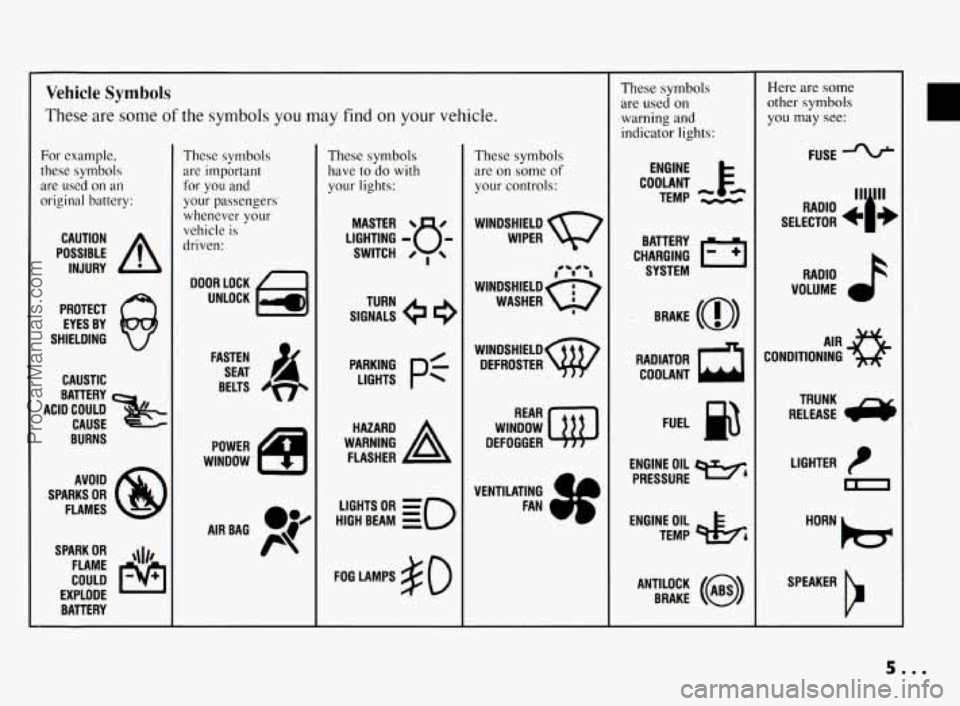
Vehicle Symbols
These are some of the symbols you may find on your vehicle.
For example,
these symbols
are used on an
original battery:
POSSIBLE A
CAUTION
INJURY
PROTECT EYES BY
SHIELDING
CAUSTIC
ACID COULD BATTERY
CAUSE
BURNS
AVOID
SPARKS
OR
FLAMES
SPARK
OR ,111,
COULD FLAME
EXPLODE BATTERY
These symbols
are important
for you and
your passengers
whenever your
vehicle
is
driven:
DOOR LOCK
UNLOCK
FASTEN SEAT
4
BELTS
POWER
WINDOW
'* -- I
These symbols
have to do with
your lights:
SIGNALS e
TURN
HIGH BEAM
OR = =o
FOG LAMPS $0
These symbols
are
on some of
your controls:
WIPER Q7
WINDSHIELD
DEFROSTER
WINDOW
DEFOGGER
VENTILATING
4
FAN (I
These symbols
are used
on
warning and
indicator lights:
COOLANT Fa
TEMP --
ENGINE
CHARGING
I-1
BATTERY SYSTEM
BRAKE
(0)
RADIATOR COOLANT
FUEL
ENGINE OIL
PRESSURE
Wb
TEMP OIL ?b
ANTILOCK (@)
BRAKE
Here are some
other symbols
you may see:
FUSE
11lp RADIO , - -
SELECTOR b I JE
RADIO
VOLUME
CONDITIONING
AIR 43
LIGHTER
m
SPEAKER
b
5.00
ProCarManuals.com
Page 45 of 290
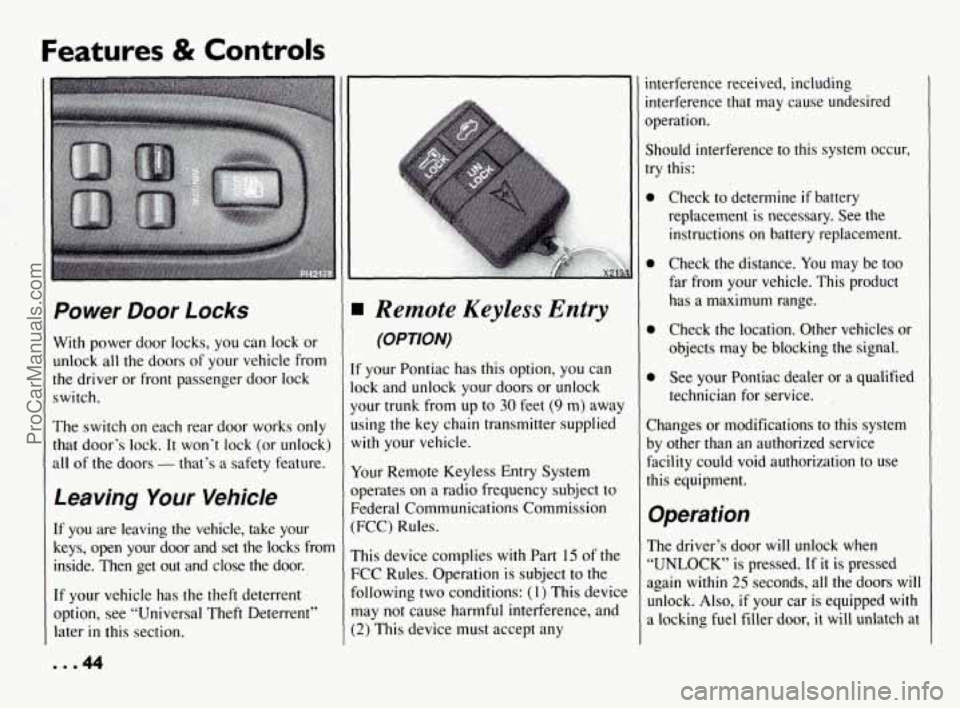
Features & Controls
Power Door Locks
With power door locks, you can lock or
unlock all the doors of your vehicle from
the driver or front passenger door lock
switch.
The switch on each rear door works only
that door’s lock.
It won’t lock (or unlock)
all
of the doors - that’s a safety feature.
Leaving Your Vehicle
If you are leaving the vehicle, take your
keys, open your door and set the locks from
inside. Then get out and close the door.
If your vehicle has
the theft deterrent
option, see “Universal Theft Deterrent”
later
in this section.
..a44
Remote Keyless Entry
(OPTION)
If your Pontiac has this option, you can
lock and unlock your doors or unlock
your
trunk from up to 30 feet (9 m) away
using the key chain transmitter supplied
with your vehicle.
Your Remote Keyless Entry System
operates on a radio frequency subject to
Federal Communications Commission
(FCC) Rules.
This device complies
with Part 15 of the
FCC Rules. Operation is subject to the
following two conditions:
(I) This devict
may not cause harmful interference, and
(2) This device must accept any interference received, including
interference that may cause undesired
3peration.
Should interference to this system occur,
try
this:
0 Check to determine if battery
replacement is necessary. See the
instructions on battery replacement.
0 Check the distance. You may be too
far from your vehicle. This product
has a maximum range.
0 Check the location. Other vehicles or
objects may be blocking
the signal.
0 See your Pontiac dealer or a qualified
technician for service.
Changes or modifications to this system
by other than an authorized service
facility could void authorization to use
this equipment.
Operafion
The driver’s door will unlock when
“UNLOCK’ is pressed. If
it is pressed
again
within 25 seconds, all the doors will
unlock. Also, if your car is equipped with
a locking fuel filler door, it will unlatch at
ProCarManuals.com
Page 46 of 290
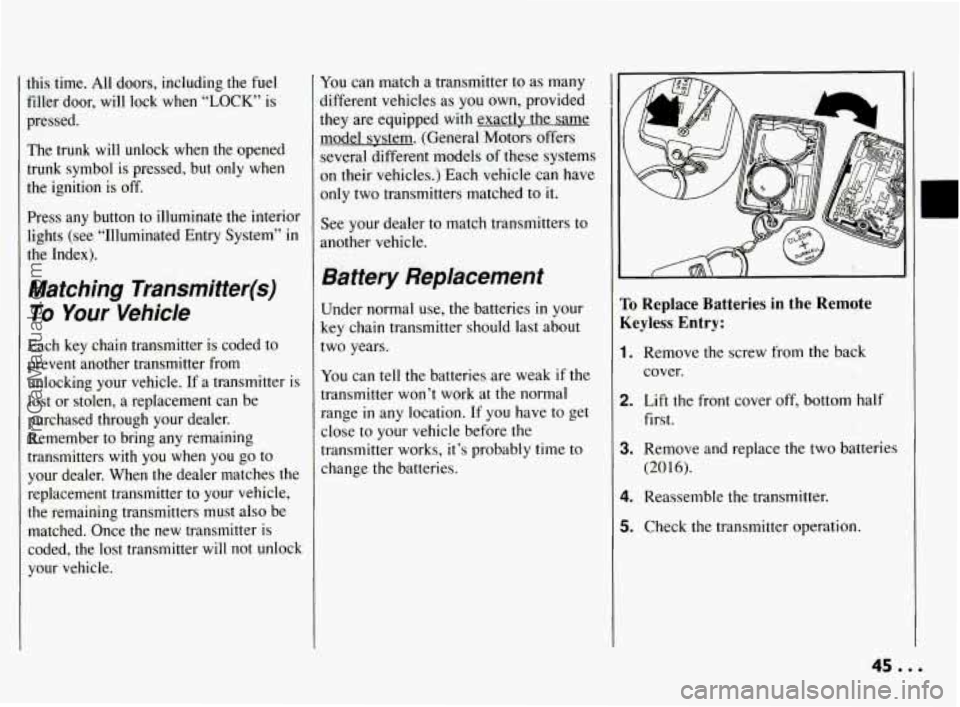
this time. All doors, including the fuel
filler door,
will lock when “LOCK” is
pressed.
The trunk
will unlock when the opened
trunk symbol is pressed, but only when
the ignition is off.
Press any button to illuminate the interior
lights (see “Illuminated Entry System’’
in
the Index).
Matching Transmitter(s)
To Your Vehicle
Each key chain transmitter is coded to
prevent another transmitter from
unlocking your vehicle. If a transmitter is
lost or stolen,
a replacement can be
purchased through your dealer.
Remember
to bring any remaining
transmitters
with you when you go to
your dealer. When the dealer matches the
replacement transmitter to your vehicle,
the remaining transmitters
must also be
matched. Once the new transmitter is
coded, the lost transmitter
will not unlock
your vehicle.
You can match a transmitter to as many
different vehicles as
you own, provided
they are equipped with exactlv the same
model system. (General Motors offers
several different models of these systems
on their vehicles.) Each vehicle can have
only two transmitters matched to it.
See your dealer to match transmitters to
another vehicle.
Battery Replacement
Under normal use, the batteries in your
key chain transmitter should last about
two years.
You can tell the batteries are weak if the
transmitter won’t work at the normal
range
in any location. If you have to get
close to your vehicle before the
transmitter works, it’s probably time
to
change the batteries.
ro Replace Batteries in the Remote
Keyless Entry:
I. Remove the screw from the back
cover.
2. Lift the front cover off, bottom half
first.
3. Remove and replace the two batteries
(2016).
4. Reassemble the transmitter.
i. Check the transmitter operation.
45e.o
ProCarManuals.com
Page 49 of 290
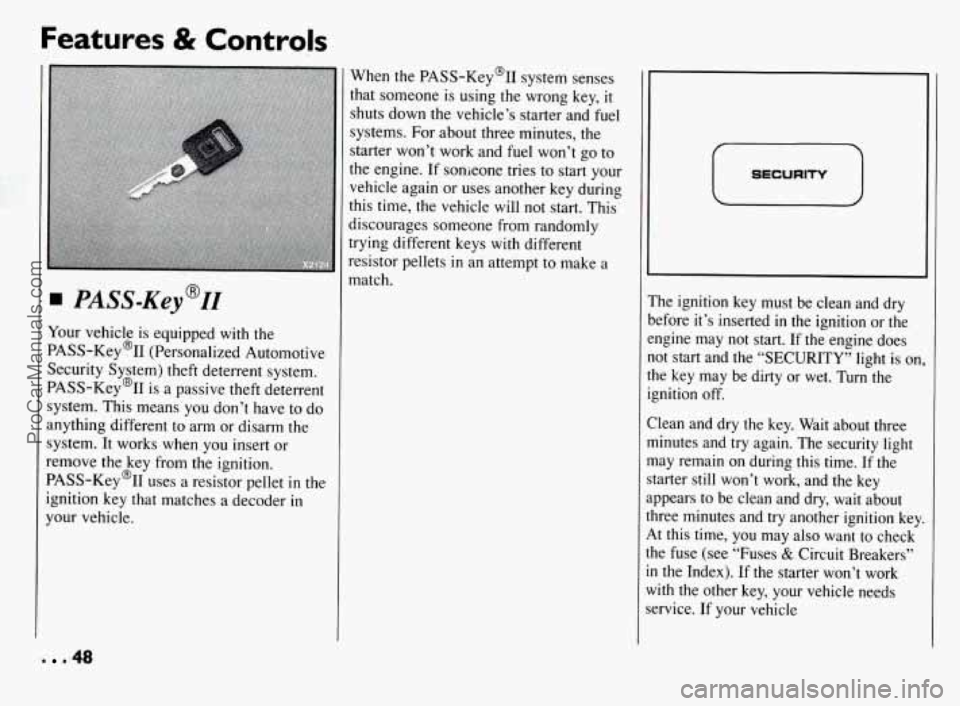
Features & Controls
Your vehicle is equipped with the
PASS-Key’II (Personalized Automotive
Security System) theft deterrent system.
PASS-Key’II is a passive theft deterrent
system. This means you don’t have to do
anything different to arm or disarm the
system. It works when you insert or
remove the key from the ignition.
PASS-Key@II uses a resistor pellet
in the
ignition key that matches a decoder
in
your vehicle. When
the PASS-Key@II system senses
that someone is using the wrong key,
it
shuts down the vehicle’s starter and fuel
systems. For about three minutes, the
starter won’t work and
fuel won’t go to
the engine. If someone tries to start your
vehicle again or uses another key during
this time, the vehicle will not start. This
discourages someone from randomly
trying different keys with different
resistor pellets in an attempt to make a
match.
7 SECURITY
The ignition key must be clean and dry
before it’s inserted in the ignition or the
engine may not start. If the engine does
not start and the “SECURITY” light is on,
the key may be dirty or wet. Turn the
ignition off.
Clean and dry the key. Wait about three
minutes and try again. The security tight
may remain on during this time. If the
starter still won’t work, and the key
ippears to be clean and dry, wait about
:hree minutes and try another ignition key.
4t this time, you may also want to check
the fuse (see “Fuses
& Circuit Breakers”
in the Index). If the starter won’t work
with the other key, your vehicle needs
service. If your vehicle
. -48
ProCarManuals.com
Page 55 of 290
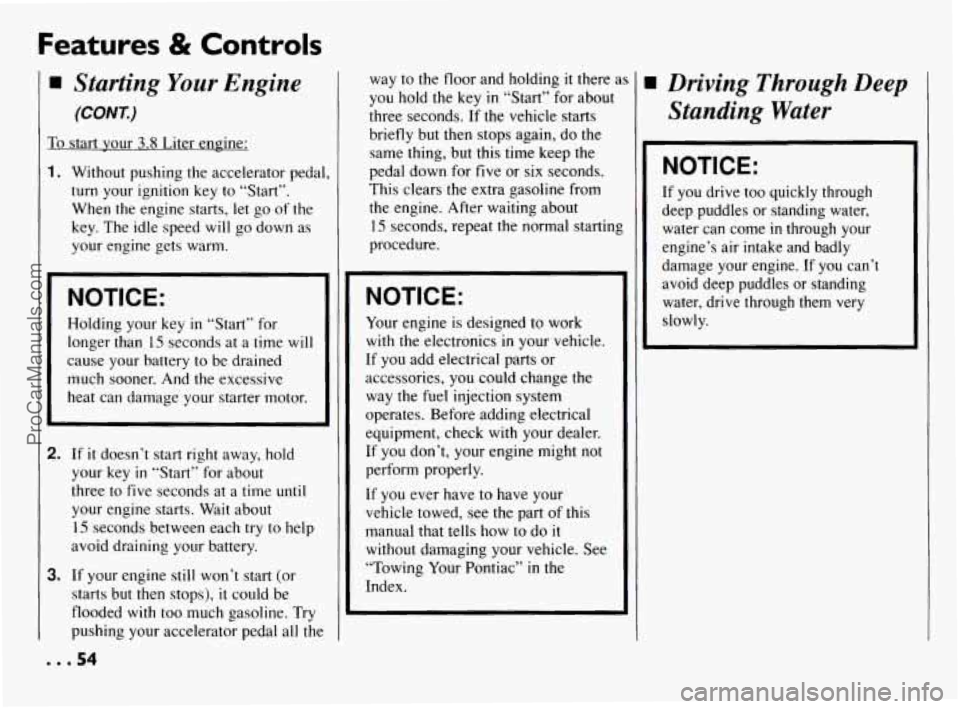
Features & Controls
.
Starting Your Engine
(CONK)
To start your 3.8 Liter engine:
1. Without pushing the accelerator pedal,
turn your ignition
key to “Start”.
When the engine starts,
let go of the
key. The idle speed will go down as
your engine gets warm.
NOTICE:
Holding your key in “Start” for
longer than
15 seconds at a time will
cause your battery
to be drained
much sooner. And the excessive
heat can damage your starter motor.
2. If it doesn’t start right away, hold
your key
in “Start” for about
three to five seconds at a time until
your engine starts. Wait about
15 seconds between each try to help
avoid draining your battery.
3. If your engine still won’t start (or
starts but then stops),
it could be
flooded with
too much gasoline. Try
pushing your accelerator pedal all the
,.a54
way to the floor and holding it there a
you hold the key in “Start” for about
three seconds.
If the vehicle starts
briefly but then stops again, do the
same thing, but this time keep the
pedal down for five or six seconds.
This clears the extra gasoline from
the engine. After waiting about
15 seconds, repeat the normal startin8
procedure.
NOTICE:
Your engine is designed to work
with the electronics
in your vehicle.
If you add electrical parts or
accessories, you could change the
way the fuel injection system
operates. Before adding electrical
equipment, check with your dealer. If you don’t, your engine might not
perform properly.
If you ever have to have your
vehicle towed, see the part of this
manual that tells how
to do it
without damaging your vehicle. See
“Towing Your Pontiac”
in the
Index.
I Driving Through Deep
Standing Water
NOTICE:
If you drive too quickly through
deep puddles or standing water,
water can come
in through your
engine’s air intake and badly
damage your engine. If you can’t
avoid deep puddles or standing
water, drive through
them very
slowly.
ProCarManuals.com
Page 56 of 290
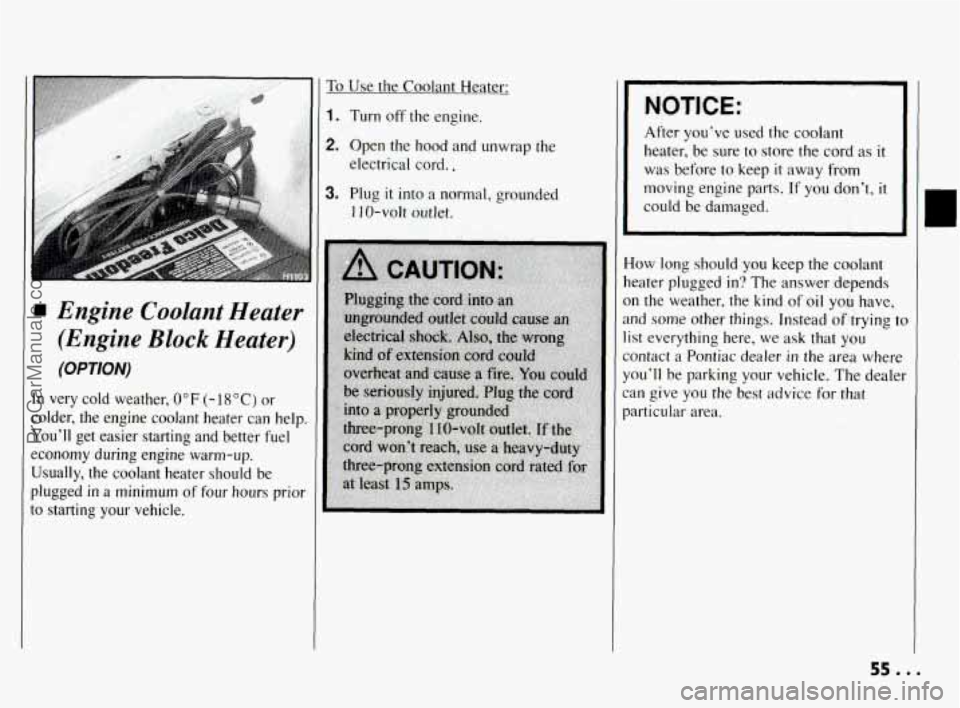
1 Engine Coolant Heater (Engine Block Heater)
(OPTION)
In very cold weather, 0" F (- 18 O C) or
colder, the engine coolant heater can help.
You'll get easier starting and better fuel
economy during engine warm-up.
Usually, the coolant heater should be
plugged
in a minimum of four hours prior
to starting your vehicle.
To Use the Coolant Heater:
1. Turn off the engine.
2. Open the hood and unwrap the
electrical cord.,
3. Plug it into a normal, grounded
110-volt outlet.
NOTICE:
After you've used the coolant
heater, be sure
to store the cord as it
was before to keep
it away from
moving engine parts. If
you don't, it
could be damaged.
How long should you keep the coolant
heater plugged in? The answer depends
on the weather, the kind of oil you have,
and
some other things. Instead of trying to
list everything here, we ask that you
contact a Pontiac dealer in the area where
you'll be parking your vehicle. The dealer
can give
you the best advice for that
particular area.
55.D.
ProCarManuals.com
Page 61 of 290
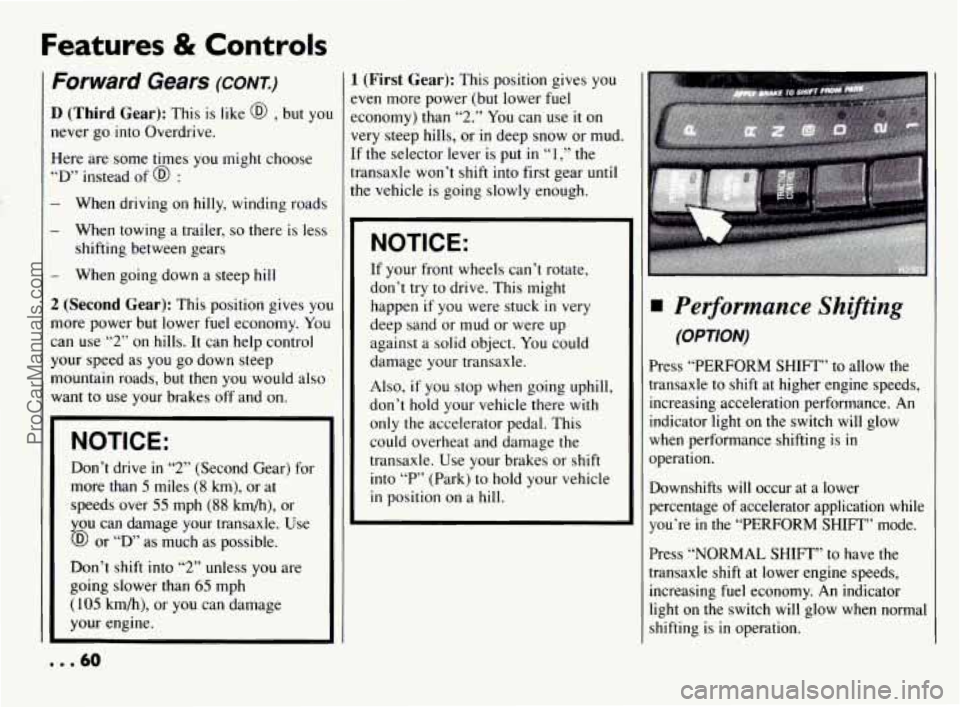
Features & Controls
Forward Gears (CONT)
D (Third Gear): This is like @ , but you
never
go into Overdrive.
Here are some times you might choose
“D’ instead of @ :
- When driving on hilly, winding roads
- When towing a trailer, so there is less
shifting between gears
- When going down a steep hill
2 (Second Gear): This position gives you
more power but lower
fuel economy. You
can use “2” on hills.
It can help control
your speed as you
go down steep
mountain roads, but
then you would also
want
to use your brakes off and on.
NOTICE:
Don’t drive in “2” (Second Gear) for
more than
5 miles (8 km), or at
speeds over
55 mph (88 km/h), or
you can damage your transaxle. Use
@ or “D’ as much as possible.
Don’t shift into “2” unless
you are
going slower than
65 mph
( 105 km/h), or you can damage
your engine.
1 (First Gear): This position gives you
even more power (but lower fuel economy) than
“2.” You can use it on
very steep hills, or in deep snow or mud.
If the selector lever is put
in “1,” the
transaxle won’t shift into first gear until
the vehicle is going slowly enough.
NOTICE:
If your front wheels can’t rotate,
don’t try to drive. This might
happen
if you were stuck in very
deep sand or mud or were up
against a solid object. You could
damage your transaxle.
Also,
if you stop when going uphill,
don’t hold your vehicle there with
only the accelerator pedal. This could overheat and damage the
transaxle. Use your brakes or shift
into
“P’ (Park) to hold your vehicle
in position on a hill.
Performance Shiftins
(OPTION)
Press “PERFORM SHIFT” to allow the
transaxle to shift at higher engine speeds,
increasing acceleration performance.
An
indicator light on the switch will glow
when performance shifting is in
operation.
Downshifts
will occur at a lower
percentage of accelerator application while
you’re
in the “PERFORM SHIFT” mode.
Press “NORMAL
SHIFT” to have the
transaxle shift at lower engine speeds,
increasing fuel economy.
An indicator
light on the switch will glow when normal
shifting
is in operation.
... 60
ProCarManuals.com
Page 88 of 290
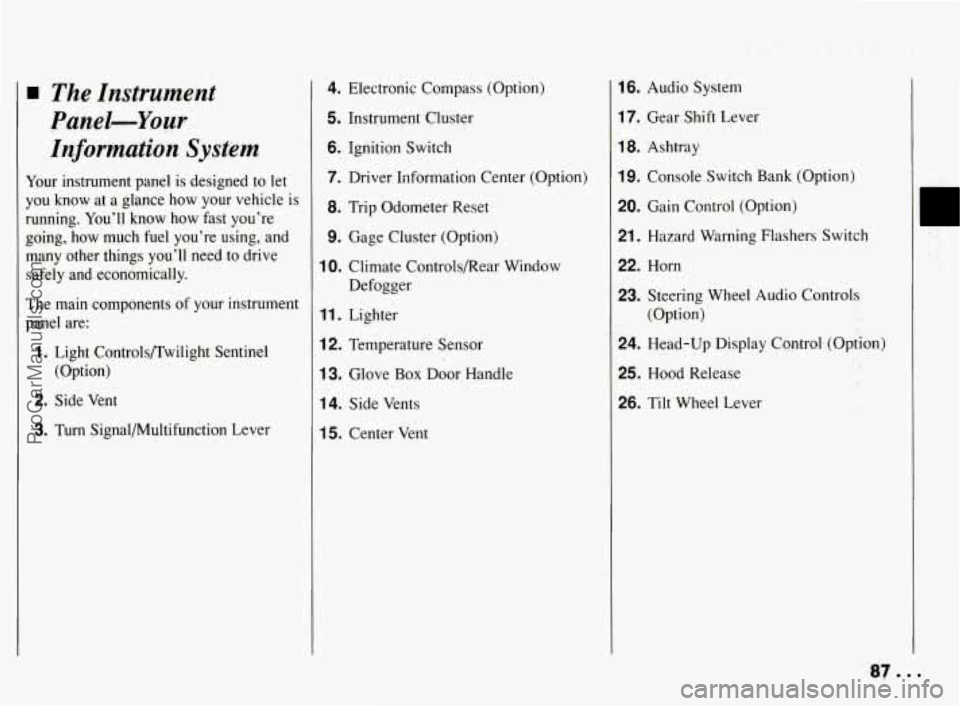
The Instrument
Panel-Your
Information System
Your instrument panel is designed to let
you
know at a glance how your vehicle is
running.
You’ll know how fast you’re
going, how much fuel you’re using, and
many other things you’ll need to drive
safely and economically;
.. .L .
The main components of your instrument
panel are:
1. Light Controls/Twilight Sentinel
(Option)
2. Side Vent
3. Turn Signal/Multifunction Lever
4. Electronic Compass (Option)
5. Instrument Cluster
6. Ignition Switch
7. Driver Information Center (Option)
8. Trip Odometer Reset
9. Gage Cluster (Option)
10. Climate Controls/Rear Window
Defogger
11. Lighter
12. Temperature Sensor
13. Glove Box Door Handle
14. Side Vents
15. Center Vent
16. Audio System
17. Gear Shift Lever
18. Ashtray
19. Console Switch Bank (Option)
20. Gain Control (Option)
21. Hazard Warning Flashers Switch
22. Horn
23. Steering Wheel Audio Controls
(Option)
24. Head-Up Display Cqntrol. (Option)
25. Hood Release
26. Tilt Wheel Lever
I
ProCarManuals.com
Page 89 of 290
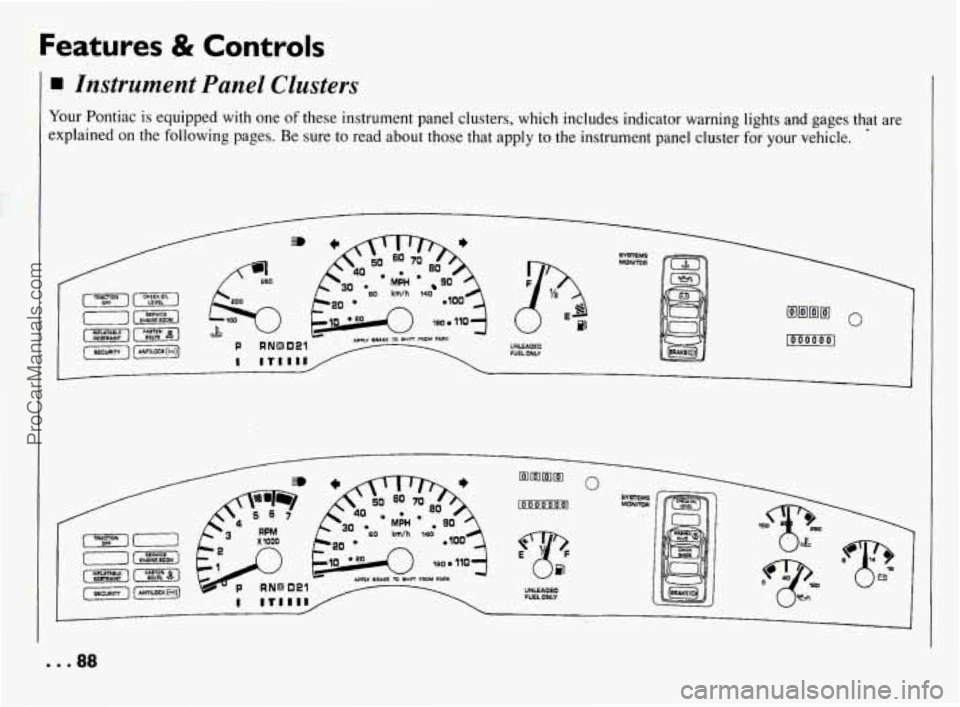
Features 8t Controls
Instrument Panel Clusters
Your Pontiac is equipped with one of these instrument panel clusters, which \
includes indicator warning lights and gages that are
explained
on the following pages. Be sure to read about those that apply to the instrument panel cluster for your vehicle.
30 *60 kmlh (40 MPH 90
eo '
I
UNLEADED NELONLV
loooooool
UNLEAOEO
FUEL ONLY
ProCarManuals.com
Page 97 of 290
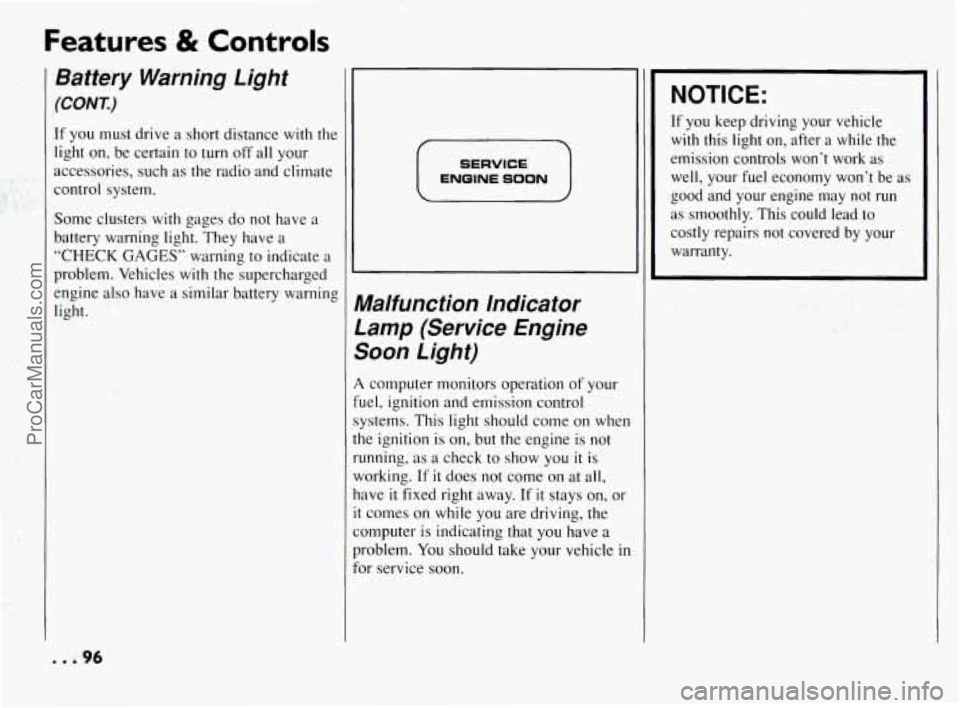
Features & Controls
Battery Warning Light
(CONT.)
If you must drive a short distance with the
light
on, be certain to turn off all your
accessories, such as
the radio and climate
control system.
Some clusters with gages do not have a
battery warning light. They have
a
“CHECK GAGES” warning to indicate a
problem. Vehicles with the supercharged
engine also have a similar battery warning
light.
SERVICE
ENGINE SOON
Malfunction Indicator
.amp (Service Engine
Soon Light)
1 computer monitors operation of your
uel, ignition and emission control
ystems. This light should come on when
he ignition is on, but the engine is not
unning, as a check
to show you it is
iorking. If
it does not come on at all,
ave
it fixed right away. If it stays on, or
: comes on while you are driving, the
omputer is indicating that you have
a
roblem. You should take your vehicle in
x- service soon.
NOTICE:
If you keep driving your vehicle
with this light on, after a while the
emission controls won’t work as
well,
your fuel economy won’t be as
good and your engine may not
run
as smoothly. This could lead to
costly repairs not covered by your
warranty.
... 96
ProCarManuals.com